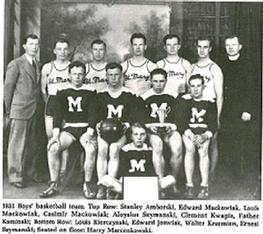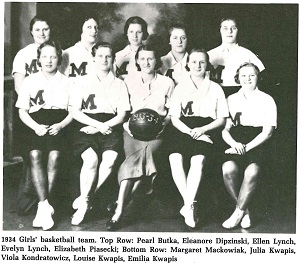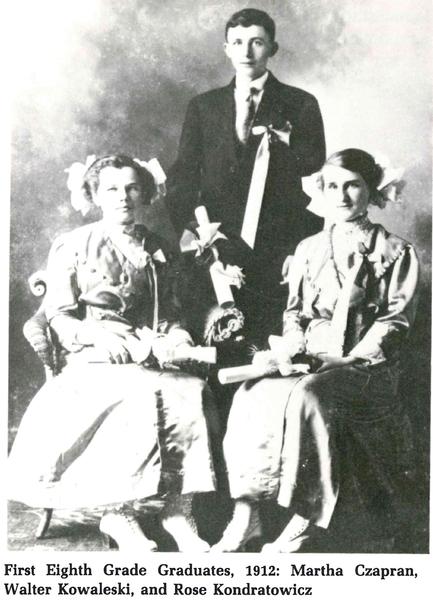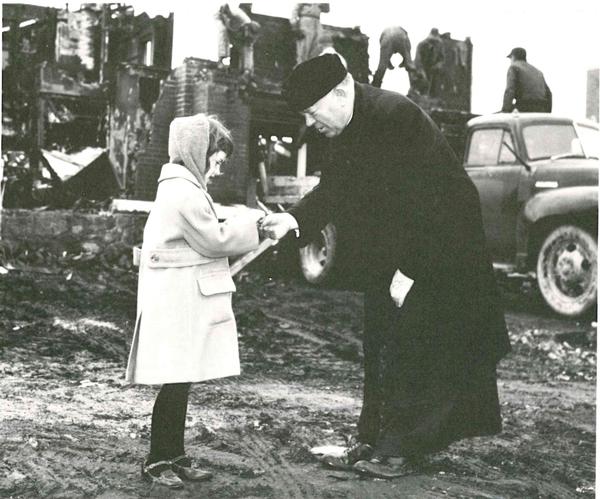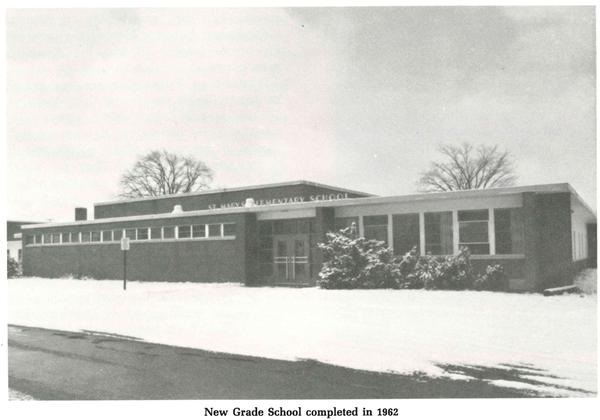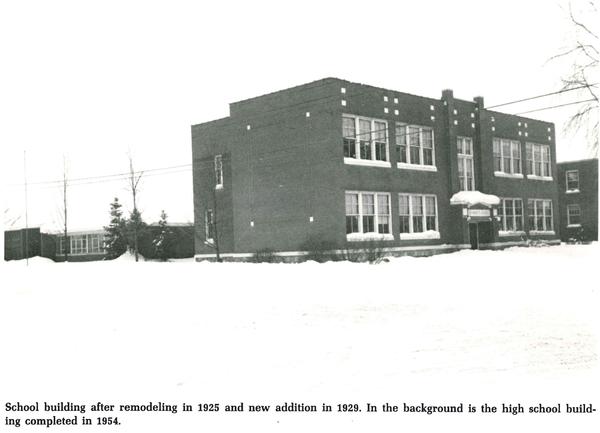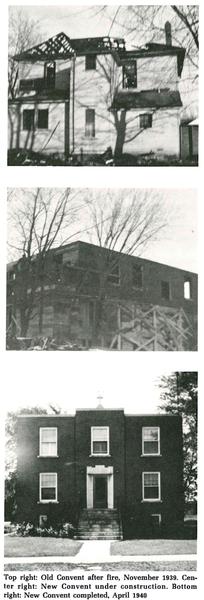History
St. Mary Cathedral School began in 1894. It all started when Rev. Casimir Skory came to the parish as pastor in 1892. He felt the need for a Catholic education. Sooner than later, his wish came true with the help of Rev. Alexander Lipinski. The school opened in 1894 with fifty students enrolled. The total cost of the building then was only $1,875, and there was no tuition fee. Between 1892 and 1899, the number of families increased from 140 to 204, all of but 34 of them were Polish. The school property was again enlarged in 1895 with purchase of four more lots costing $360. Between 1894 and 1905 the school had one lay teacher; from 1905 to 1909, two teachers were employed to provide for the increasing number of students, a number which had reached 120. Meanwhile in the late 1890’s Father Skory began raising funds for a new church building. They managed to build the new church without borrowing money.
The period from 1904 through 1935 encompassed the two pastorates of Father Simon Ponganis, and the intervening time from 1907 to 1913 when Father Francis Kaczmarek served as pastor. Father Kaczmarek built a new rectory which was completed in the spring of 1909. With the completion of the new rectory, the old rectory building was used to house sisters. The first four Dominican Sisters from the Grand Rapids Congregation arrived to teach on August 27, 1909. They were: Sister Raymond Hudzinski, who was the principal and the teacher of about 10 older children who were at the seventh and eighth grade levels; Sister Casimir Zukowski, who had 72 children in grades four, five, and six and also taught music and played the organ for church services; Sister Dolores, who taught 30 children in grades one through three; and Sister Juliana who was the housekeeper. The first class of three graduated from eighth grade in 1912.
The young school, still gaining strength, was almost shut down in the mid-1920s. With the anti-Catholicism influence of the Ku Klux Klan, an amendment was proposed to the state constitution that would end the existence of all private and parochial schools. When the pastor, Monsignor Ponganis returned from leave and found out what may possibly happen to the school, he was dismayed. So with the extreme effort of Ponganis and other Michigan citizens, the amendment was defeated. In January 1923, Ponganis began fundraising for a complete remodeling of the current school building to make it meet state standard for establishing a high school. The project was completed in 1925 and included an almost complete rebuilding of the existing structure. The high school grew gradually adding one grade each year. Additional extra-curricular activities such as music, drama, and sports were added. The first boys’ basketball team was organized in 1927-28 when the first class was at the junior level. The boys wore suits purchased by their parents from Sears and Roebuck for $3 each. A girls’ basketball team was organized in 1930-31.
The first high school graduation took place on June 12, 1929. As the first class was nearing graduation, Sister DeLellis and Monsignor Ponganis sought accreditation for the high school from the State Department of Public Instruction. The visitors were stratified with the program of instruction but found that space was inadequate, a fact that was already evident to the sisters. Construction of an addition of four rooms – one for assembly, the other three for classes- began in early July 1929. The cost of the new addition, which was ready for occupancy on October 3, was approximately $20,000, a little less than originally anticipated. Some founds were borrowed so that construction could be finished on time, but the funds were repaid quickly. Having satisfied the requirements set by the state, St. Mary High School was accredited in May 1931.
With the declining health of Monsignor Ponganis in 1936, Father Francis Kaminski, having already served five years as associate pastor, was installed as pastor in 1936. After the Great Depression the parish finances began to rebound. A fire struck the Sister’s Convent in 1939 destroying it. The parish rallied together to rebuild it immediately at a cost of $12,500, the new building had three floors and provided spaced for eight occupants.
Through the late 40’s and 50’s Otsego county saw an increase in population. The number of families increased from 250 in 1945 to 430 in 1950. The school continuously gained popularity and with the famous "baby boom" of the mid-1900's, the number of students enrolled rose greatly. Enrollment rose from 195 in 1945 to 472 in 1960. Fr. Kaminski began planning in 1949 to increase the size of the school. However, before the high school project began, Kaminski made needed repairs to the church roof and bell tower to the tune of $38,000. Construction on eight new classrooms and a gymnasium were finished by 1954. The cost of the building and its new furnishings was approximately $300,000. Almost one-third of this amount was covered by donations and fund-raising projects before and during construction; but it proved necessary for the parish to enter into short-term borrowing from the diocese and from local lenders to cover the balance. The generosity of parishioners made it possible to pay these debts in full by the end of 1957. The increase in enrollment necessitated an increase in staffing during the 1950’s, a staffing need that was met through employment of lay teachers beginning in 1951.
The concerns related to staffing paled into insignificance when the elementary school burned on November 30, 1960. The fire, which may have started in a box of wastepaper nearer the rear exit, was discovered about 10:50 a.m. Father Eugene Golas, the assistant pastor, who was teaching a class in the high school, went from room to room in the grade school, alerting the teachers, who were able to escort all of the 365 children safely out of the building. The building was a complete loss. Hardly had the ashes cooled than men of the parish and other volunteers began clearing the rubble in anticipation of rebuilding. The winter months and the need for careful planning deferred the beginning of construction until August 1961, at which time the contractor, McCready and Sons, began work on the fourteen-room building. Insurance on the old building provided $80,500 of the total cost of approximately $285,000; the parish received permission to borrow the remaining balance. The students and staff moved into the new building in 1962.
Aided by the community, the school was back on its feet. The 1960’s and 70’s saw a decrease in the number of religious sisters available to teach in Catholic schools. Actually, the number of sisters assigned to St. Mary School remained fairly constant throughout the 1960’s, but the increase in enrollment required additional staffing that could not be met by the Grand Rapids Dominican Sisters. Between 1962 and 1971, enrollment rose from 537 to 707; the number of lay teachers increased from 7 to 16. There were eight sisters teaching in the school year each year from 1962 to 1968, a number determined in part by the size of the convent. An addition was made to the convent in 1968 which allowed two more sisters to teach in the school. Enrollment continued to increase reaching 800 in 1974.
The financial consequences for the parish in its efforts to support the school were serious. Salary costs rose dramatically, chiefly because of the increase in the number of lay teachers but also due in part to the need of higher salaries for the sisters to support rising costs that their congregation had to meet. As the school began showing yearly operating deficits and parish contributions no longer covered the deficits, the school board, which had been established in 1966, considered the possibility of charging tuition. In 1969-1970 a tuition plan was introduced, one in which each family with one or more children in school was charged $100. Around the same time Michigan voters in a referendum defeated the “Educaid” bill which would have allowed public funding for non-public schools. Gaylord Public Schools, however, continued the shared time program allowing Gaylord teachers to teach certain non-core classes at St. Mary School.
In 1971 the school board asked petitions about the future of the school. Responses to the questionnaire showed overwhelming support for retaining both schools; and increase in tuition was recommended as the major means of additional support. Based on these findings, the tuition was raised to $200 per family with an additional charge of $10 per elementary student and $25 per high school student with a maximum charge of $300.
Aside from financing, there were other items of interest relating to the schools. Curricular opportunities for high school students were diversified by the inauguration in 1962 of a shared time program with Gaylord Community High School. Almost all St. Mary students participated in the program that allowed them to take certain classes at the public school. This also made it possible for St. Mary School to phase out the corresponding course that it had been offering. Many activities that had become traditional in earlier decades persisted into the 1960’s: student retreats; sodality meetings; May Crowning; Junior-Senior Banquet; dances; dramatic presentations; “Skip Day”; and commencement activities, including breakfast with the sisters after Baccalaureate Mass. Athletics continued to be the most popular of extracurricular activities. The high school added football to its athletic program in 1967; and, although it took a while to field a winning team, parents and other parishioners took great interest in the program. Baseball continued to be a popular and often successful sports program. A girls’ track team was organized in 1968, and girls’ basketball was revived in 1971. Boys’ basketball, however, remained the sport of primary interest. The success or lack of it on the part of the varsity team was a matter of concern among people of the parish, especially the members of the Athletic Association. The issue became a heated one following a disappointing record in the 1968-1969 season, as pressure form the Athletic Association forced the resignation of the coaches, some of whom had also been teaching classes.
More effective administration of the schools was made possible in 1961-62 through the establishment of a separate principalship for the grade school. Sister Jean Catherine Bierscheid served in that position from 1961 to 1963, followed by Sister Michaela Schrems from 1963-1975. Sister Roch Alvesteffer succeeded Sister Alphonse Mary LaValley as high school principal in 1962 serving until 1968. Sister Thaddeus Kowalinski was the next high school administrator for the period form 1968-1972. The Home and School Association, which had been organized in 1958 in keeping with diocesan directives, continued to function in the early 1960’s as a forum for administrators, teachers, and parents to collaborate in their efforts to educate the children.
With the influx of new population into Otsego county, Msgr. Kaminski announced plans to build a new church to make room for all the parishioners and summer tourists. A parish census in 1967 showed 859 families, half of which were new since 1957. A new parish was established in July 1965 in Vanderbilt, Holy Redeemer Parish to meet the needs of northern Otsego county.
News of the creation of the Diocese of Gaylord and of the appointment of its first bishop, Edmund C. Szoka by Pope Paul VI, reached the hometown people on June 15, 1971. It is the combination of the northern counties of the Dioceses of Grand Rapids and Saginaw. The Mass of Ordination and Installation was held in the gymnasium at St Mary School. Plan began under the direction of the new bishop and the rector of the Cathedral Parish to design and build a new cathedral and rectory. The entire process was lengthy and riffled with contract problems, delays, and construction problems. But in 1976 the new Cathedral was solemnly consecrated by Bishop Szoka with Cardinal Dearden preaching the homily and many other prelates in attendance. A few years later, having spent almost his entire priesthood ministering to the people of St Mary, the beloved pastor and shepherd, Msgr. Kaminski entered retirement in the summer of 1980. Father James Suchocki was named the next rector of the Cathedral.
Education of the children and young people remained a priority for St. Mary. The school board, or the Board of Total Education as it was now known, because of its assuming responsibility for the CCD-Religious Educaiton Program as was as for the schools, considered adding a kindergarten to the elementary grades. The Board and Parish Council approved this proposal on condition that there would be as least 40 children prepared to enroll, a condition that was not men in 1982 until 1984. With the curriculum developed by Linda Diekman, it was a hit. After the addition of the kindergarten, a computer and reading lab was installed. The school administration in the 1980’s reaffirmed the philosophy of education at St. Mary as it had been expressed in earlier years, as “an expression of the mission entrusted by Jesus to the Church He founded” and as “a privileged means of promoting the formation of the whole person, especially for the formation and education in the faith.” The principals emphasized the importance of sharing the responsibility of education with the parents. The struggle to support this total education program, especially the schools, did not cease. The Stewardship Drive helped the parish to meets its annual obligations. Tuition was usually increased every other year and by 1983 reached a range from $470 for one child to $970 for four or more children per family; non-parishioners were assessed twice the amount. To the annual July or August festival was added another major fund-raiser, a dinner-dance in January or February at the K of C Hall for which patrons paid $100 per person. The proceeds from the fundraisers, increased tuition, and occasional large donations, together with the increase in Sunday collection prompted by the Stewardship Drive (an increase by 1982 of approximately $1,300 per Sunday), provided resources for the gradual reduction in the cathedral building debt and for holding the line on the school deficit.
In 1986, the elementary school received national recognition under the principalship of Marlene Peplinski. Peplinski, along with then superintendent and pastor Rev. James Suhocki, traveled to Washington D.C. and met President Ronald Regan and Secretary of Education, William Bennet. When asked about winning the National Exemplary Award and going to Washington D.C., Peplinski said, "It was a very big honor."
From then on, the school maintained an excellent reputation which it still holds today. St. Mary Cathedral School celebrated it's centennial anniversary in 1994. Previous superintendent Rev. Francis Murphy was asked how a school survives 100 years. His response was simply "It's a walk in faith... We operate totally and fully on the good will and sacrifice...of the parish." When Rev. James Suhocki was asked about the school and it's 100th anniversary, he said "My wish is that the 100 years of tradition will be a building block for another 100 years. I think it's a great school. Many people of the community would agree with this.
Bibliography:
History of the School – From St. Mary Cathedral School Website – accesed 10/24/16
Centennial Cathedral School Supplement Edition (1994)
Sown on Good Ground by Sr. Alice O’Rourke, 1984


